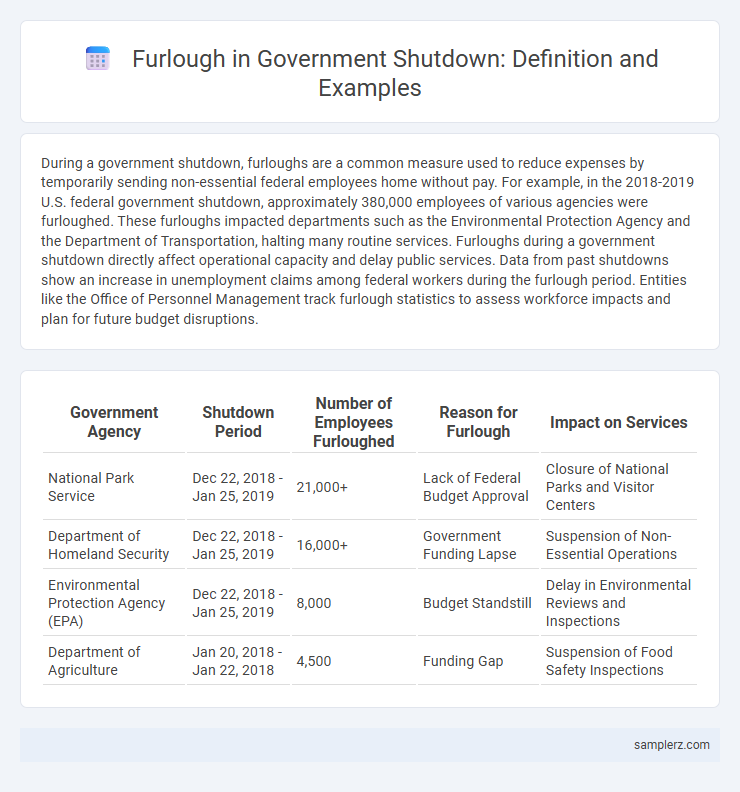During a government shutdown, furloughs are a common measure used to reduce expenses by temporarily sending non-essential federal employees home without pay. For example, in the 2018-2019 U.S. federal government shutdown, approximately 380,000 employees of various agencies were furloughed. These furloughs impacted departments such as the Environmental Protection Agency and the Department of Transportation, halting many routine services. Furloughs during a government shutdown directly affect operational capacity and delay public services. Data from past shutdowns show an increase in unemployment claims among federal workers during the furlough period. Entities like the Office of Personnel Management track furlough statistics to assess workforce impacts and plan for future budget disruptions.
Table of Comparison
| Government Agency | Shutdown Period | Number of Employees Furloughed | Reason for Furlough | Impact on Services |
|---|---|---|---|---|
| National Park Service | Dec 22, 2018 - Jan 25, 2019 | 21,000+ | Lack of Federal Budget Approval | Closure of National Parks and Visitor Centers |
| Department of Homeland Security | Dec 22, 2018 - Jan 25, 2019 | 16,000+ | Government Funding Lapse | Suspension of Non-Essential Operations |
| Environmental Protection Agency (EPA) | Dec 22, 2018 - Jan 25, 2019 | 8,000 | Budget Standstill | Delay in Environmental Reviews and Inspections |
| Department of Agriculture | Jan 20, 2018 - Jan 22, 2018 | 4,500 | Funding Gap | Suspension of Food Safety Inspections |
Definition and Overview of Furloughs During Government Shutdowns
Furloughs during government shutdowns refer to mandatory, temporary unpaid leave imposed on federal employees when funding lapses halt non-essential operations. These furloughs prevent thousands of workers from performing duties and receiving pay until appropriations resume. Typically, essential personnel remain on duty without pay, while furloughed employees are prohibited from working and compensated retroactively once the government reopens.
Historical Examples of Furloughs in U.S. Government Shutdowns
During the 2013 U.S. government shutdown, over 800,000 federal employees were furloughed due to a budget impasse, halting services across numerous agencies such as the National Park Service and the Internal Revenue Service. Similarly, the 2018-2019 shutdown, the longest in U.S. history lasting 35 days, resulted in approximately 380,000 federal workers being placed on unpaid furloughs, affecting departments like Homeland Security and the Food and Drug Administration. These shutdown-induced furloughs highlight the significant operational and economic impacts on federal workforce and public services during legislative deadlocks.
Case Study: 2013 Federal Government Shutdown Furloughs
During the 2013 Federal Government Shutdown, approximately 850,000 federal employees experienced furloughs, resulting in unpaid leave and service disruptions across multiple agencies. Key impacted departments included the Environmental Protection Agency, National Park Service, and Internal Revenue Service, highlighting vulnerabilities in government operations during funding lapses. This shutdown underscored the significant operational and economic consequences of furloughs in prolonged budget impasses.
Impact of Furloughs on Federal Employees
Furloughs during government shutdowns lead to temporary unpaid leave for federal employees, causing significant financial strain and disruption in personal budgeting. These unpaid absences result in decreased morale and productivity, as employees face uncertainty about job security and benefits. The interruption in government services also affects public trust, highlighting the broader economic and social consequences of furlough policies.
Essential vs. Non-Essential Workers in a Shutdown Furlough
During a government shutdown furlough, essential workers such as active duty military personnel, law enforcement officers, and emergency responders remain on duty despite the suspension of federal funding, ensuring critical operations continue uninterrupted. Non-essential workers, including many administrative staff and support employees, are placed on temporary unpaid leave until funding is restored. This distinction impacts workforce management, government service delivery, and payroll processing throughout the shutdown period.
Furlough Procedures and Implementation Process
Furlough procedures during a government shutdown typically begin with agency leaders issuing official notices to employees outlining the specific duration and terms of unpaid leave in compliance with the Antideficiency Act. Implementation processes include categorizing employees into excepted and non-excepted roles based on essential functions, followed by coordination with human resources to manage payroll adjustments and maintain communication regarding benefit continuations. Agencies ensure adherence to Office of Personnel Management (OPM) guidelines to standardize furlough documentation and support employee inquiries throughout the shutdown period.
Economic Consequences of Government Furloughs
Government furloughs during shutdowns lead to immediate income loss for federal employees, reducing consumer spending and decreasing overall economic activity. Extended furloughs disrupt public services, delay projects, and create uncertainty in sectors dependent on government contracts, further slowing economic growth. The ripple effect impacts local businesses and tax revenues, exacerbating fiscal challenges at both state and federal levels.
Legal Framework Governing Shutdown Furloughs
The legal framework governing shutdown furloughs is primarily anchored in the Antideficiency Act, which prohibits federal agencies from obligating funds in the absence of appropriations, necessitating furloughs during government shutdowns. Courts have upheld this statute, reinforcing that employees cannot work without pay when appropriations lapse, thereby mandating furloughs. These regulations ensure compliance with fiscal law while protecting the government from unauthorized expenditures during shutdown periods.
Furloughs in State and Local Government Shutdowns
Furloughs in state and local government shutdowns commonly affect essential services like public safety, education, and transportation, causing temporary unpaid leave for many employees. During the 2013 federal government shutdown, several state and local agencies mirrored similar furlough patterns, reducing workforce availability and delaying critical projects. These furloughs disrupt service delivery and strain budgets, highlighting the financial vulnerabilities of subnational governments during funding lapses.
Lessons Learned from Previous Government Furloughs
Government furloughs during shutdowns, such as the 2013 and 2018-2019 federal shutdowns, revealed critical weaknesses in contingency planning and employee communication strategies. Analysis showed the importance of ensuring timely funding decisions and implementing clear guidelines for essential and non-essential employee status to minimize disruptions. Lessons learned emphasize enhancing inter-agency coordination and establishing more resilient operational protocols to mitigate future furlough impacts.

example of furlough in shutdown Infographic
 samplerz.com
samplerz.com